Haapavesi 作者: 来源: 发布时间:2021-06-21
一、所属省或是州,具体位置,人口,面积
Haapavesi is a town and a municipality of Finland. It is located in the North Ostrobothnia region. The town has a population of 6,853 (31 January 2019) and covers an area of 1,086.11 square kilometres (419.35 sq mi) of which 36.41 km2 (14.06 sq mi) is water. The population density is 6.53 inhabitants per square kilometre (16.9/sq mi). Neighbour municipalities are Haapajärvi, Kärsämäki, Nivala, Oulainen, Raahe, Siikalatva and Ylivieska. The population of Haapavesi is the 137th largest in Finland, which includes 21.1% of children, 62.4% of young people, 16.5% of people who are over 65 years old. At the end of 2017, Haapavesi had 6,970 inhabitants, of which 4,131 lived in agglomerations, 2,804 in sparsely populated areas and the coordinates of the place of residence of 35 inhabitants were unknown. The degree of agglomeration is calculated for those residents whose coordinates of residence are known; The degree of agglomeration of aspen water is 59.6%. The population of aspen water agglomerations is divided between two different agglomerations
The municipality is unilingually Finnish. The town is the Finnish national kantele village. It is also known for the Haapavesi Folk Music Festival which gathers folkmusicians together. At Haapavesi, there is a 327 metres (1,073 ft) tall guyed TV mast, which belongs to Finland's tallest man-made structures.
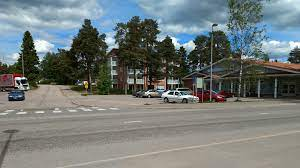
二、自然地理
1.地理条件
The landscape of the northern and southern part of Aspen Water is dominated by extensive marshlands. The central part of the municipality is a more varied, hilly terrain enlivened by water bodies. The residential and arable areas are concentrated in the central part of the municipality along the Pyhäjoki River. The bedrock of aspen water has a varied rock species composition. The central and eastern parts of the municipality are dominated by various granites, the north and south by quartz granodiorite and various shales. Of the movable soils, peat is by far the most common. Moraine is most common in the central part of the municipality. Gravel and sand are mainly in the north in the Karhukangas region, where the Iisalmi-Vieremän-Raahe ridge period begins. The Pyhäjoki valley is largely filled with clay and silt layers.
The landscape of aspen water differs from most Ostrobothnian river basins due to its hilly and lake-like nature. However, the overall look of the landscape is again marked by the expanse of Ostrobothnia; the hilly lands are gently sloping and the lakes shallow. The terrain varies around Korkattijärvi, Rytkyjärvi and the expansion of Pyhäjoki, Haapajärvi. The highest elevation of the municipality is Korkattivuori (186 m) on the northeast side of Lake Korkattijärvi near the church village-Pulkkila roads.
About two-thirds of the municipality's forest lands have been marshy. There are almost 30% of the municipality's surface area, which is almost devoid of trees. The largest of the Neva are Piipsanneva on the eastern border of the municipality, Haaponeva south of Pirnesjärvi and Susineva in the southeastern part of the municipality. Piipsanneva is the largest unified rehabilitated peatland in the Nordic countries. Pyhäjoki, which crosses aspen water, collects water from the entire municipality. In addition to Korkattijärvi, Rytkyjärvi and Haapajärvi, the largest lakes are Iso and Pieni Vatjusjärvi to the south of the church village and Osmanki and Ainali to the north of the church village. Osmanki and Ainali are among the best bird lakes in Finland.
2. 交通情况
Distances and transportation
Oulu 111 km (airport, railway station, port, bus station)
Ylivieska 54 km (railway station)
Oulainen 43km (railway station)
Kokkola 134km (airport, railway station, port, bus station)
Kajani 122 km (airport, railway station, port, bus station)
Nivala 47 km (golf course)
三、经济发展和规模
The earliest livelihoods of aspen were fishing, hunting and agriculture. Tar burning began in the early 17th century and was at its most extensive in the late twentieth century. The popularity of tar burning was mainly influenced by the favorable location of Haapavesi, the Pyhäjoki River, which crosses the municipality, made it easy to transport tar to the coast.
The Haapavesi Technology Village is home to the Verso business incubator, which operates in the Haapavesi-Siikalatva region and serves not only business planners and fresh businesses, but also entrepreneurs in the region in business matters. The Municipal tax rate of Haapavesi is arround 20.75%.
All the necessary information, consulting and services relating to entrepreneurship can be obtained from the head of economic development and business industry department Mrs. Marjaana Tuomikoski tel.+358 (0)44 7591 306
四、产业特点重点项目
The largest employers in the Haapavesi area are BM Haapavesi Oy, Oy Darekon Ltd, Hasa, Agronic Oy, M-Filter Ab, the Siika-Pyhäjoki area education consortium and Valio.
Haapaveden Teknologiakylä Oy is a business development company founded in 1989. It is a community dedicated to supporting and facilitating the day-to-day running of the business by producing and maintaining a variety of business premises solutions and technologies, as well as providing a wide range of expert services. Haapavesi Technology Village houses 25 companies and 7 units in the city of Haapavesi, which employ about 100 people.
五、风景名胜,景点( attractions)
1. Korkatti Naturetrail
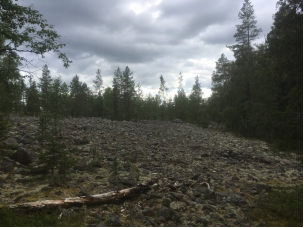
Lots of different sights in nature, landscapes, different forest, damn field, red rocks, and so on. Lots of nature to see, landscapes, different kinds of forest, red rocks etc. If you're a person that likes being outdoors, you have to see this.
2. Korkattivuori
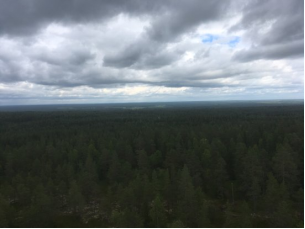
10.7 km from the center of Haapavesi Korkattivuori is the highest place in the western part of Oulu County. Exceptional views and a nature trail make it an interesting excursion destination in Northern Ostrobothnia. The top of the mountain rises 186.6 meters above sea level
3. Harkaahonkoski waterfall
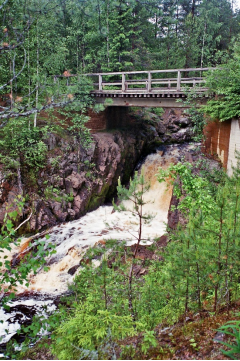
Härkäahonkoski is a tiered waterfall that flows in the Kuonanjoki River in Haapajärvi. The waterfall is located about 2.5 kilometres upstream of the lake that the river flows into: the Hautaperä artifical lake. With a total drop height of about 4 metres, the fall is one of the most impressive sights in the Haapajärvi municipality.
The fall begins under a wooden bridge. Before the fall, there is about 50 metres of rapids, where the flowing of the river accelerates into white water. The first and bigger of the drops is almost three metres high and is followed by a second, smaller drop, with a height of one to two metres. The main fall is very steep, practically vertical, and the smaller one is more like a shallow cascade. The river calms down right after the falls.
The Kuonanjoki River gets its water from the Kuonanjärvi lake, which is located about 10 kilometres east of the fall. In the nearby Haittaperä dam, the river splits into two channels so that the natural (old) stream bed of the Kuonanjoki River (with little water) flows into the Haapajärvi lake whereas the artificial stream bed, mined in the 1970’s, flows through Härkäahonkoski waterfall into the Hautaperä articifial lake. The water in the artificial lake runs the Haapajärvi hydroelectric plant.
六、历史文化
1.历史
The earliest livelihoods of aspen were fishing, hunting and agriculture. Tar burning began in the early 17th century and was at its most extensive in the late twentieth century. The popularity of tar burning was mainly influenced by the favorable location of Haapavesi, the Pyhäjoki River, which crosses the municipality, made it easy to transport tar to the coast. Partly due to the large-scale tar burning, Haapavesi's industrial activities were almost non-existent for a long time. On Spa Island in the immediate vicinity of the church village, there was a health spa in 1887–1926, where mud and clay baths were given. Water from Asko's health spring was enjoyed between the baths. Haapavesi had a population of about 4,500 in the mid-1860s. During the great years of famine, the municipality's population fell below 4,000. By 1920, however, the population of the municipality was already over 7,000.
Haapavesi is mentioned as the chapel parish of the Pyhäjoki parish at least as early as the 1640s, when the municipality's first pulpit was built. It was separated as an independent parish in 1863, which, however, did not materialize in practice until 1874. The municipality of Haapavesi was founded as early as 1866. Until the 1870s, Haapajärvi was called Haapajärvi. The second church of the parish was built in the 1690s and the third wooden cruciform church, which burned down in 1981, in 1784. The present church of the municipality was completed in 1984.
Haapavesi is closely related to the history of Finnish skiing. The best-known skiers in the region are Aappo Luomajoki (1845–1919), winner of the first Oulu skis (1889), Juho Ritola (1871–1959), Matti Koskenkorva (1880–1965) and Tapani Niku, who won the first Finnish skiing Olympic medal. With the success of Haapavesi skiers, the type of ski developed in Haapavesi, the so-called aspen water, which soon spread widely beyond Aspen Water. Aspen water was previously used as a so-called. longer than the forest ski (length almost 3 m) and narrower (width approx. 7 cm). Aspen was popular with racers from the 1880s to the 1910s.
2. 文化
The oldest human finds in Aspen Water date back to the Stone Age. In the vicinity of Ainali in particular, many finds dating to the Stone Age have been found. Haapavesi, located around Kalainen's Pyhäjoki River, was an important wilderness area during the Iron Age. Permanent settlement spread to Haapavesi in the 16th century. Residents who settled on the banks of the Pyhäjoki River came mainly from Savo, but also partly from the coast.
Abundance of lakes, picturesque landscape, coastal trails on the territory of the town provide opportunities for walking and fishing. Thanks to the unparallel landscapes Haapavesi is called the pearl of Northern Ostrobothnia. Also, active volunteering of numerous non-government organizations of the town provides opportunities for different hobbies. Below we list places for leisure provided by the municipality and non-government organizations.
Haapavesi provides a wide scope of services for leisure and recreation for the citizens and visitors. In our town there are beautiful nature objects for sports and open air events. Abundance of lakes, picturesque landscape, coastal trails on the territory of the town provide opportunities for walking and fishing. Thanks to the unparallel landscapes Haapavesi is called the pearl of Northern Ostrobothnia.
Haapavesi is primarily known in Finland as a stronghold of traditional Kantele music; A folk festival is held annually in the city.
七、其他信息
In 1892, Sergeant Nora Pöyhönen founded the Haapavesi School of Economics, Finland's first school of economics for girls. The original name of the educational institution was the Nursery and Cooking School, later a home economics college, and the host school. Today, the school belongs to Haapavesi Vocational School.
The area around Haapavesi is quite attractive compared to the otherwise intensively agricultural landscape of Ostrobothnia and is interspersed with numerous lakes and swamps. Lake Ainali in particular captivates with its abundance of birds.
One of the main branches of activity is peat cutting; the Piipsanneva mining area is one of the largest in Europe. More recently, the city has tried to profile itself as a high-tech location. Haapavesi, with its high school and vocational college, is important for the region as an educational location.
The Haapavesi Folk High School is an ideologically independent boarding school. Haapavesi Folk High School is one of the eleven folk high schools cooperating in the HUMAK University of Applied Sciences. HUMAK offers education and training in the fields of Civic and youth work, Cultural management and production as well as Sign language interpreter. In Haapavesi Unit of HUMAK the focus is on civic and youth work.
八、联系方式
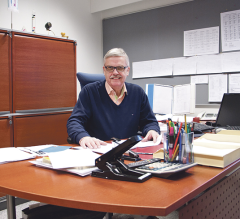
Mayor of Haapavesi: Veli Tirilä
Website:https://www.haapavesi.fi
Phone number: +358 (0)8 45911
Email: KAUPUNKI@HAAPAVESI.FI/ NEUVONTA@HAAPAVESI.FI
Address: TÄHTELÄNKUJA 1 (CITY HALL)
86601 HAAPAVESI
FINLAND
Facebook: @Haapavedenkaupunki
